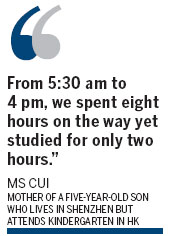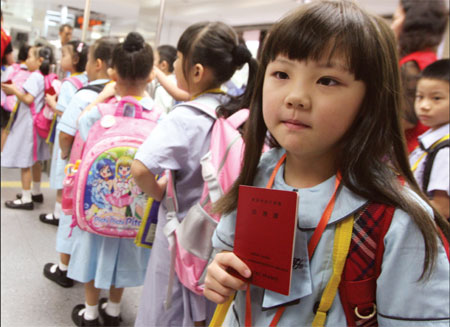Kids late for school as tangled in red tape
Updated: 2012-09-04 06:52
By Michelle Fei(HK Edition)
|
|||||||||
|
Cross-boundary students line-up and wait for clearance at Lo Wu Spur Line boundary control points on Monday as they leave their Shenzhen homes for the first day of this semester in Hong Kong. Edmond Tang / China Daily |

Parent calls 'terrible, miserable' day, despite introduction of new scanner
Monday morning saw chaos at border crossings from the mainland, as a record 17,000 students who live in Shenzhen but go to school in Hong Kong crossed the border, heading for classes on the first day of the fall term.
With the cross border student enrollment up 30 percent over last year, immigration officials couldn't cope with the numbers, despite a new digital scanner designed to assess each student's documents in seconds.
Ms Cui, a Shenzhen resident in her 30s, accompanied her five-year-old son, Zhang Mingju, on Monday and described the whole procedure as "terrible and miserable".
The kindergarten student woke up at 5:30 am and traveled to the Futian Check Point at 8 o'clock, and then spent an hour and a half waiting in lines to cross the border.
The nanny bus for cross-boundary students arrived at the newly opened Elite Kids Anglo-Chinese Kindergarten at 10 o'clock, an hour and a half after school started. Classes ended for the day at noon. And Ms Cui and her son spent another four hours to travel back home.
"From 5:30 am to 4 pm, we spent eight hours on the way yet studied for only two hours," said Mrs Cui.
Even with the long delays, the new bar code scanners were estimated to have cut waiting times by half. About a thousand students at the three major ports of entry, Huanggang, Wen Jindu and Sha Toujia didn't even have to get off their nanny buses, while immigration staff got on board with their scanners.
"I heard there was quite a lot of chaos at the check points today. Eighty percent of cross boundary students, were late for school today," Chan Yee-wa, president of Elite Kids Kindergarten told China Daily. He did add however, "the on-bus-checking method was absolutely goods news for the young students. It reduced potential dangers with students stepping on and off the bus and walking though the port hall by themselves,"
The majority of cross boundary students were kindergarten kids, some as young as two, according to official statistics.
"It would be very difficult to recognize your students as students, nannies and teachers are all unfamiliar with each other on the very first day," said Chan.
Only 1, 600 students out of 17,000 had applied for the digital code bar, adapting the "traditional" ways to cross the border and spent more than one hour waiting for the "approval stamps".
"There are so many cross-boundary students at the check points; if you didn't register for the digital code, it would be a long long tortuous way to school," said Ms Cui, appealing to the government to promote the advanced way of crossing the border even more vigorously.
Speaking of the low registration rate for the digital bar code among cross boundary students, one of the major reasons was that the students, especially those born to mainland parents, were disconnected from Hong Kong during the summer vacation, and had no idea that they should register for the digital code.
"We made many phone calls to ask the parents to send materials to register for the advanced way to pass the border, yet many of them were out of reach during the summer," said a spokesperson for the Association of Shenzhen-Hong Kong Cross-boundary Nanny Bus Companies, whose bus company serves over 1,000 Hong Kong students whose parents are mainlanders.
Many of the nanny bus companies which were unable to contact the parents of cross border students took it upon themselves to apply for the digital bar codes on behalf of students.
"Sometimes we even pre-paid the tuition fee for students whose parents lived on the mainland we are getting multi-functional," the spokesperson half-joked.
Five major ports in Shenzhen had allocated 18 scanning devices to promote the new way of crossing the border. Another 28 scanners will be pressed into service shortly. Innformation for digital code will be updated annually, while information for traditional permit is updated every five years.
michelle@chinadailyhk.com
(HK Edition 09/04/2012 page1)
